Blum Crew – Assigned 755th Squadron – July 6, 1944
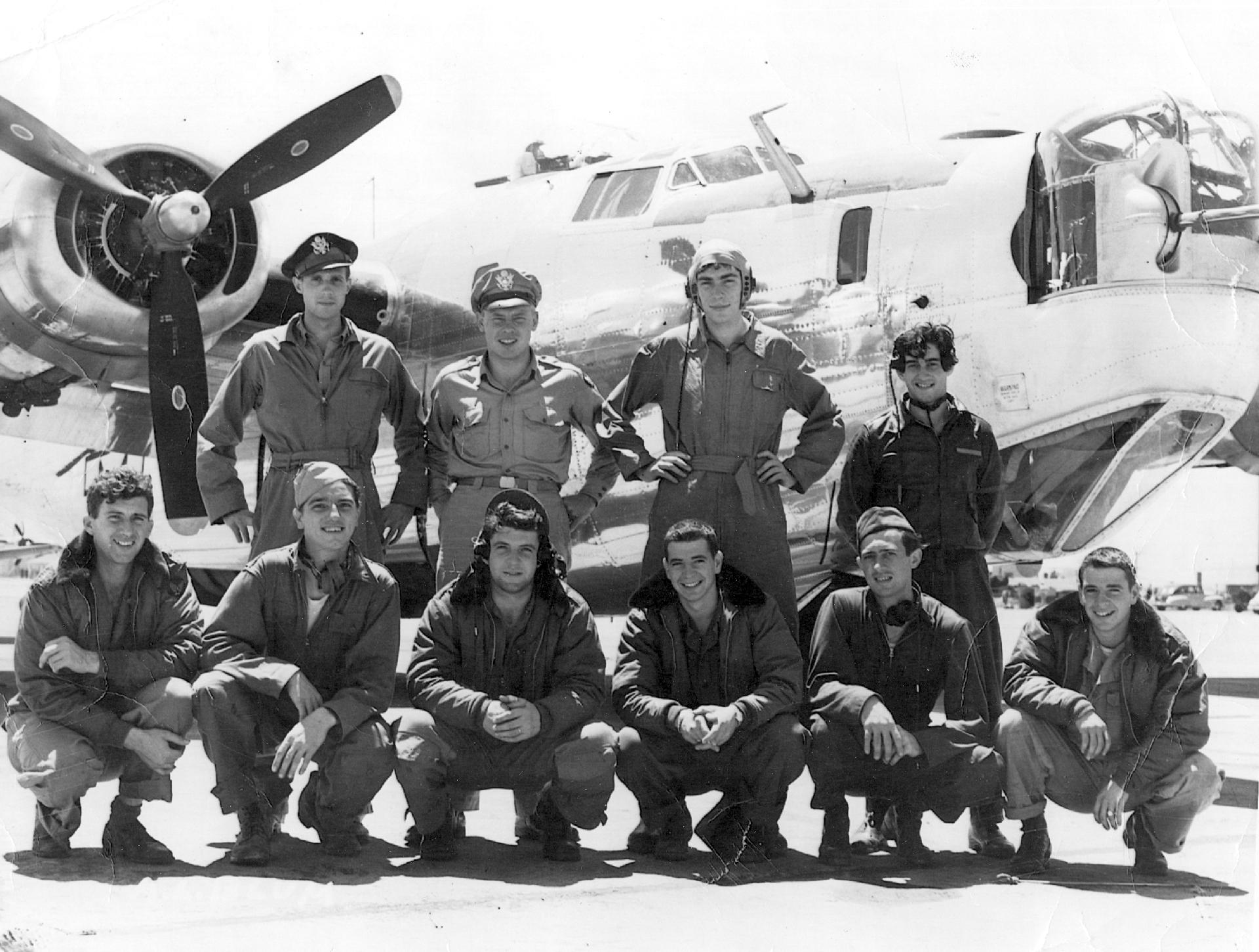
Blum Crew – Most completed tour March 1945
| Rank | Name | Serial # | Crew Position | Date | Status | Comments |
|---|---|---|---|---|---|---|
| Capt | Allen L Blum | 0818820 | Pilot | Apr-45 | CT | Awards - Distinguished Flying Cross |
| 1Lt | Ben E Drenth | 0553533 | Co-pilot | 17-May-45 | UNK | Transferred to 753rd Sqdn |
| 2Lt | Edward Silver | 0716977 | Navigator | 27-Nov-44 | UNK | TD to HQ 2Bomb Div |
| 1Lt | Arthur E Guest | 0886705 | Bombardier | Mar-45 | UNK | Awards - Silver OLC to Air Medal |
| S/Sgt | Walter J Zotter | 33280343 | Radio Operator | 05-Sep-44 | UNK | Promoted to T/Sgt |
| T/Sgt | Patrick M Differ | 13021311 | Flight Engineer | Apr-45 | CT | Transf to 70RD Ret to ZI |
| S/Sgt | Richard M Biron | 16049490 | Radio Operator | Mar-45 | CT | Transf to 70RD Ret to ZI |
| S/Sgt | Donald E Echols | 19206300 | Aerial Gunner | Sep-44 | WIA | Purple Heart for Aug 25, 1944 |
| S/sgt | William W Holt | 15171327 | Airplane Armorer-Gunner | Mar-45 | CT | Transf to 70RD Ret to ZI |
| S/Sgt | John E Echols | 19206292 | Aerial Gunner | Mar-45 | CT | Transf to 70RD Ret to ZI |
Allen Blum’s crew was the only crew in the 458th – possibly the 8th Air Force that could boast a set of twin brothers, S/Sgt’s Don and John Echols, from El Monte, California. Don was wounded on his 14th mission, spent time in hospital in England, and was eventually sent back to the States in November 1944 where he became a gunnery instructor and later served on B-29’s. John Echols and most of Blum’s crew were assigned as a lead crew and completed a tour of combat missions in March 1945.
Missions
| Date | Target | 458th Msn | Pilot Msn | Cmd Pilot | LD | Serial | RCL | Sqdn | A/C Msn | A/C Name | Comments |
|---|---|---|---|---|---|---|---|---|---|---|---|
| 13-Jul-44 | SAARBRUCKEN | 90 | 1 | 42-95120 | M | J3 | 23 | HOOKEM COW / BETTY | |||
| 16-Jul-44 | SAARBRUCKEN | 91 | 2 | 41-29342 | S | J3 | 30 | ROUGH RIDERS | |||
| 18-Jul-44 | TROARN | 93 | 3 | 41-29342 | S | J3 | 32 | ROUGH RIDERS | |||
| 20-Jul-44 | EISENACH | 95 | 4 | 41-29342 | S | J3 | 33 | ROUGH RIDERS | |||
| 21-Jul-44 | MUNICH | 96 | 5 | 41-29359 | J | J3 | 50 | TAIL WIND | |||
| 25-Jul-44 | ST. LO AREA "B" | 98 | 6 | 41-29342 | S | J3 | 34 | ROUGH RIDERS | |||
| 02-Aug-44 | 3 NO BALLS | 101 | 7 | 42-100407 | A | J3 | 34 | LITTLE LAMBSY DIVEY | |||
| 05-Aug-44 | BRUNSWICK/WAGGUM | 105 | 8 | 42-100433 | B | J3 | 36 | BIG DICK HARD TO HIT | |||
| 06-Aug-44 | HAMBURG | 106 | 9 | SCHWARTZ | D1 | 42-100407 | D | J3 | 36 | LITTLE LAMBSY DIVEY | |
| 08-Aug-44 | CLASTRES | 108 | 10 | KUHN | D1 | 42-50907 | D | J3 | 2 | LILY MARLENE | |
| 12-Aug-44 | MOURMELON | 111 | 11 | 42-50864 | B | J3 | 1 | JOLLY ROGER (II?) | |||
| 14-Aug-44 | DOLE/TAVAUX | 113 | 12 | GRIFFITH | L2 | 42-50864 | B | J3 | 3 | JOLLY ROGER (II?) | |
| 25-Aug-44 | TERTRE | 119 | 13 | JAMISON | L1 | 42-50864 | B | J3 | 5 | JOLLY ROGER (II?) | ECHOLS & DRENTH WIA |
| 08-Sep-44 | KARLSRUHE | 123 | 14 | BREVAKIS | L2 | 42-50907 | D | J3 | 8 | LILY MARLENE | |
| 18-Sep-44 | HORSHAM to CLASTRES | TR02 | -- | 42-7629 | A | 755 | T1 | NOT 458TH SHIP | TRUCKIN' MISSION | ||
| 20-Sep-44 | HORSHAM to CLASTRES | TR04 | -- | 42-7642 | N | 44BG | T2 | M'DARLING | TRUCKIN' MISSION | ||
| 23-Sep-44 | HORSHAM to ST DIZIER | TR07 | -- | 41-29577 | E | 466BG | T5 | THE RUTH E-K | TRUCKIN' MISSION | ||
| 03-Oct-44 | GAGGENAU | 127 | 15 | 42-50864 | B | J3 | 6 | JOLLY ROGER (II?) | |||
| 12-Oct-44 | OSNABRUCK | 132 | 16 | CLAGGETT | L2 | 42-50864 | B | J3 | 8 | JOLLY ROGER (II?) | |
| 15-Oct-44 | MONHEIM | 134 | 17 | CLAGGETT | L3 | 42-50575 | E | J3 | 2 | UNKNOWN 020 | |
| 30-Oct-44 | HARBURG | 139 | 18 | CLAGGETT | L2 | 42-50740 | F | J3 | 5 | OUR BURMA | |
| 04-Nov-44 | MISBURG | 141 | 19 | BREVAKIS | L2 | 42-50608 | W | J3 | 6 | FILTHY McNAUGTY | |
| 30-Nov-44 | HOMBURG | 151 | 20 | -- | -- | -- | -- | No FC - Sqdn Rec's | |||
| 28-Dec-44 | ST. WENDEL | 160 | 21 | WAGNER | L2 | 42-50608 | W | J3 | 15 | FILTHY McNAUGTY | |
| 30-Dec-44 | NEUWIED | 161 | 22 | WILLIAMS | L3 | 42-50608 | W | J4 | 16 | FILTHY McNAUGTY | |
| 13-Jan-45 | KAISERLAUTERN | 169 | 23 | PHILLIP | L21 | 42-50740 | Q | J3 | 15 | OUR BURMA | |
| 17-Jan-45 | HARBURG | 172 | MSHL | -- | -- | -- | -- | MARSHALLING CHIEF | |||
| 28-Jan-45 | DORTMUND | 174 | 24 | PHILLIP | L2 | 42-50499 | U | J3 | 27 | COOKIE/OPEN POST | |
| 03-Feb-45 | MAGDEBURG | 177 | 25 | L2 | 42-50740 | Q | J3 | 18 | OUR BURMA | ||
| 06-Feb-45 | MAGDEBURG | 178 | 26 | 42-50740 | Q | J3 | 19 | OUR BURMA | |||
| 16-Feb-45 | OSNABRUCK | 183 | ABT | BRECKENRIDGE | L2 | 42-50740 | Q | J3 | -- | OUR BURMA | ABORT #2 ENG FIRE |
| 17-Feb-45 | ASCHAFFENBURG | REC | -- | BRECKENRIDGE | 42-50516 | V | J3 | -- | STARDUST | RECALL WEATHER | |
| 03-Mar-45 | NIENBURG | 195 | 27 | 42-50504 | S | J3 | 25 | UNKNOWN 019 | |||
| 07-Mar-45 | SOEST | 198 | 28 | L3 | 44-10618 | T | J3 | 7 | UNKNOWN 038 |
Don and John Echols with B-24H-15-CF 41-29342 J3 Rough Riders

Don Echols
“I well recall Rough Riders – we flew this ship several times early before being assigned our ship. Of course I mostly recall the trip on July 20, 1944 to Eisenach where we were shot up on the bomb run, dropped out of formation, and limped home with only two engines and losing gas. Noteworthy was that I eyeballed a target to jettison the bombs and more or less accidentally straddled a railroad track. I couldn’t claim a fighter but got my 20 feet of railroad track!
“Rough Riders’ was a beat [up] looking plane, but I recall our pilot, Allen Blum, saying it was a ‘sweet’ plane to fly. Well, we did nearly get back to Horsham when the third engine quit – he put it in a dive directly at the field and he and the co-pilot, Ben Drenth, muscled it level enough to hit the runway – crossways – the last engine quit as we came to a stop. There was a good write up in ‘Yank’, the Army newspaper about their feat (see below). A B-24 isn’t supposed to glide.”
Alan Blum’s Dead stick landing of Rough Riders – July 20, 1944
AN EIGHTH AIR FORCE LIBERATOR STATION, ENGLAND
1ST LIEUT. ALLEN L. BLUM (RIGHT), OF MONROE, MICH., PILOT OF THE B-24H LIBERATOR HEAVY BOMBER, EXPLAINS HIS MAGNIFICENT FEAT OF BRINGING HOME THE CONSOLIDATED MANUFACTURED PLANE [WITH] ALL MOTORS DEAD AND THE FUEL TANKS ALMOST DRY. LISTENING INTENTLY TO THE STORY OF THE MIRACULOUS LANDING IS SGT. LINWOOD YARBROUGH, ASSISTANT CREW CHIEF, OF JACKSON, MISS. SOUTH OF FRANKFURT, GERMANY, FLAK HIT THE NO. 4 ENGINE AND BLEW A HOLE IN THE CRANKCASE CAUSING HEAVY DRAINAGE OF OIL AND GAS. THE PLANE WAS FORCED TO DROP OUT OF FORMATION. “AS WE REACHED THE CHANNEL”, BLUM SAID, “WE WERE RUNNING VERY LOW ON GAS. I CALLED AIR-SEA RESCUE AND KEPT THEM INFORMED AS TO OUR POSITION IN CASE WE SHOULD BE FORCED TO DITCH. SIX MILES FROM BASE, AND 6,000 FEET ABOVE IT, OUR REMAINING THREE ENGINES QUIT. I DOVE DOWN THROUGH THE CLOUDS TO MAINTAIN FLYING SPEED AND BROKE OUT JUST SHORT OF THE FIELD. I WAS ON THE WRONG HEADING TO HIT THE END OF THE RUNWAY, SO WE LANDED DIAGONALLY IN THE GRASS.” THE BOMBER WAS MANUFACTURED AT THE CONSOLIDATED PLANT IN FORT WORTH, TEX. AND RELEASED NOVEMBER 25, 1943.
“ROUGH RIDERS” HAS A TOTAL OF 433 HOURS AND 30 MINUTES. THE BOMBER, NO. 41-29342, HAS A TOTAL OF 210 COMBAT HOURS TO ITS CREDIT AND HAS FLOWN ON 43 BOMBING MISSIONS OVER GERMANY AND OCCUPIED EUROPE. A FEW OF ITS OUTSTANDING OPERATIONS INCLUDE BERLIN, MUNICH, HAMBURG, BRUNSWICK, OSNABRUCK, EISENACH, HAMM, ALL IN GERMANY; CAEN, ST. QUENTIN, BOURGES, CHERBOURG, ST. LO AND BOLE, ALL IN FRANCE. THE ENGINES WERE MANUFACTURED BY PRATT AND WHITNEY, NO. B-1830-65. ENGINES WERE CHANGED AT 401 HOURS AND 20 MINUTES.
LIEUTENANT BLUM, SON OF MR. AND MRS. GEORGE A. BLUM, 55 EAST VINE ST. MONROE, MICH. WAS A GENERAL CLERK FOR MONROE PAPER CO. BEFORE ENTRY INTO MILITARY SERVICE. HE WAS APPOINTED SECOND LIEUT. DEC. 5, 1943 AND PROMOTED TO 1ST LIEUT. AUG. 10, 1944. HE HAS BEEN OVERSEAS SINCE JULY 12, 1944.
SGT. LINWOOD YARBROUGH, CREW CHIEF, IS THE SON OF MR. AND MRS. JAMES P. YARBROUGH, 1105 CENTRAL ST. JACKSON, MISS. HIS WIFE, MRS. ZULINE YARBROUGH, RESIDES AT THE SAME ADDRESS. SERGEANT YARBROUGH ENTERED THE ARMY NOV. 6, 1942 AND HAS BEEN OVERSEAS SINCE FEB. 1, 1944.
Press release 458th records
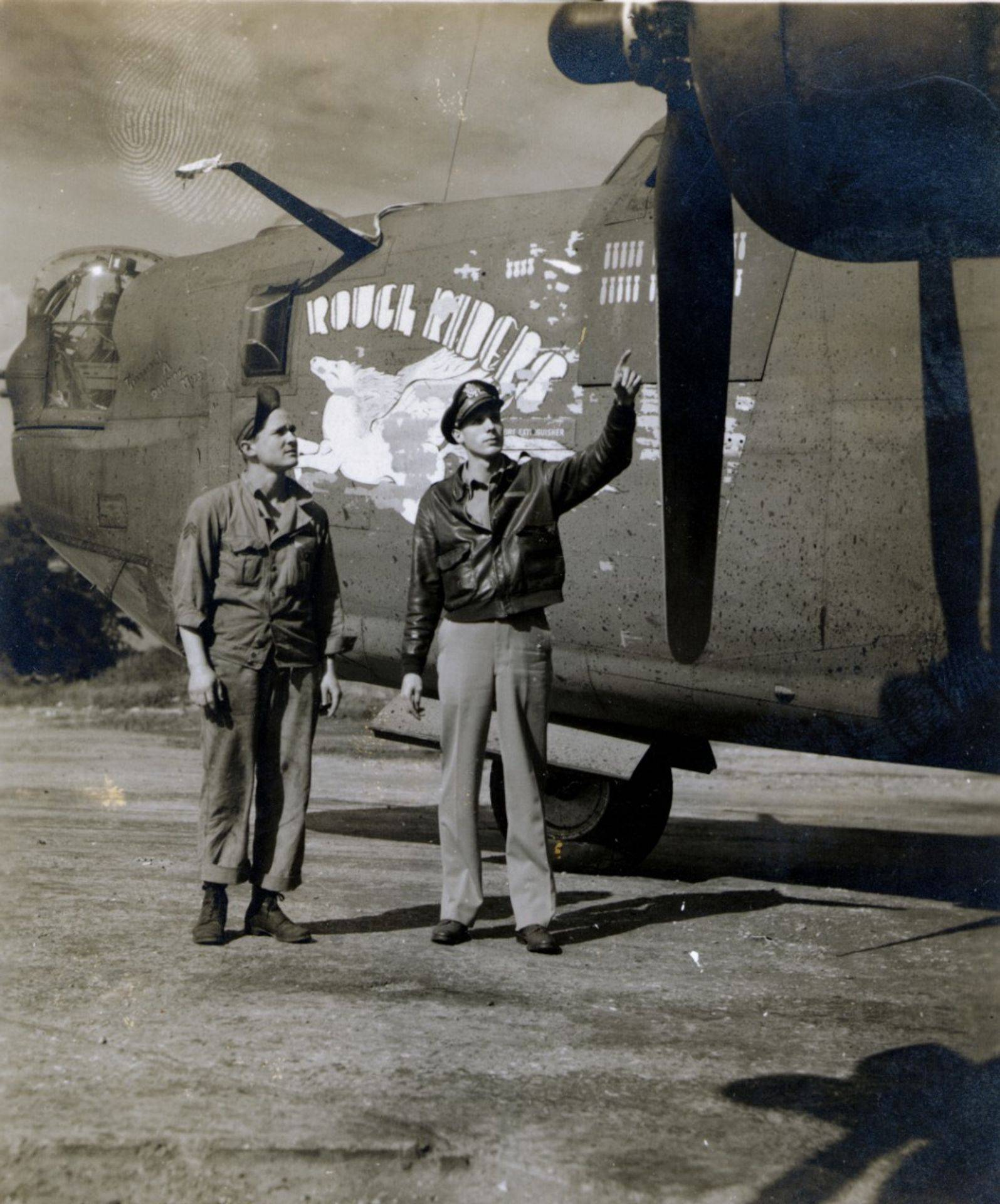
Don and John Echols – Summer 1944

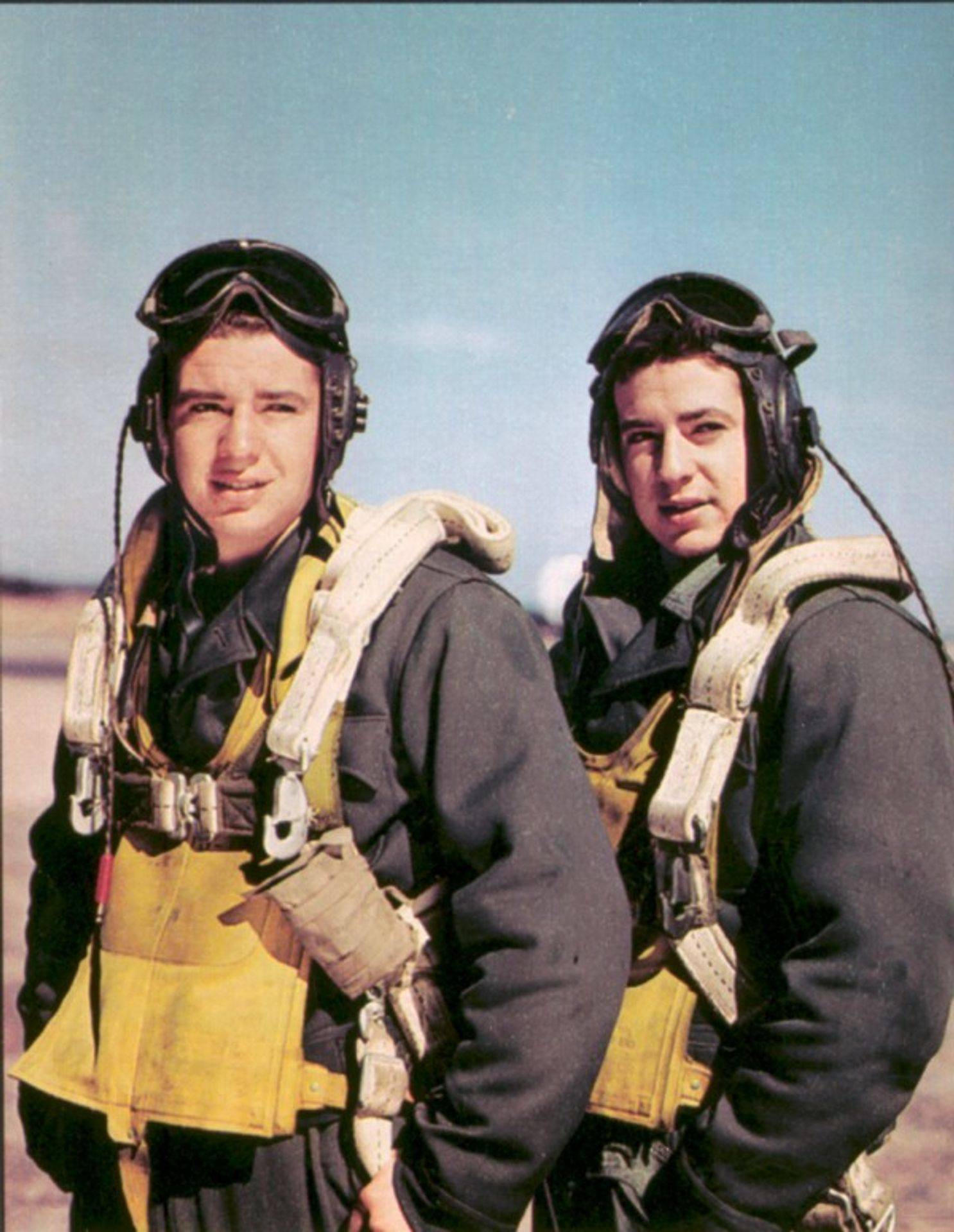
From John Echols memoir
I flew 10 missions during the first 30 days I was there, not counting the ones scrubbed or recalled after takeoff at the last minute. We were flying deep into Germany as well as to enemy air fields, etc, in France. When we were selected to lead a mission of 12 aircraft on the 25th of August, we were delighted because it was to be a short mission to Belgium. What we and our intelligence didn’t know was that the Germans had moved some of their heavy anti-aircraft railway guns to our entry point on the coast of the continent. This would be my 10th and Don’s 14th [mission]. As we crossed the coastline into Belgium, I was already in the ball turret and Don was in the act of reaching down to put on his flak suit, when a burst of flak hit us hard.
My turret was peppered with shrapnel. Don was in the waist to man the left waist gun position and Ben Drenth, our co-pilot, was in the waist section as an observer. Don and Ben were both seriously wounded. The plane was badly damaged, but we could still continue on to the target at reduced altitude. Our flight engineer, Mike Differ, came to the rear of the plane to check for damage and after reporting to the pilot, helped me give first aid to Don and Ben. Don was the most seriously wounded so we gave him a shot of morphine.
We continued to the target with excellent bombing results which were probably achieved because we were forced to drop down below 10,000 feet due to our oxygen system being knocked out by the flak damage. Going down to this low level made us like sitting ducks to the flak gunners on the ground. We lost a couple of other planes in the formation and some turned back due to damage and shot out engines. We actually ended up leading 6 planes over the target. Ben and Don were immediately rushed to an Army hospital located near our base. Ben recovered and returned to flying. Ed Silver had already been wounded and grounded while flying with another crew (see below). Don received excellent medical care and after 4 months of reconstructive surgery on his hand and wrist was returned to the States for further treatment. He was awarded the Purple Heart Medal. On return from this mission the entire crew was given a 48-hour pass to London.
Courtesy: Don and John Echols
August 25, 1944 – Target: Lubeck, Germany

Removing wounded crewmen from Liberty Lib
(Photo: Karl Lake)
The 458th flew two missions on August 25, 1944. Don Echols and Ben Drenth were wounded on the second to Tertre, Belgium. The first was flown to the Dornier aircraft factory at Lubeck, Germany. Ed Silver was on that raid. The story below is from the 2nd Air Division Association Journal, written by Rick Rokicki as told by Ed Silver.
“I flew that day as bombardier/navigator on a max-max mission with a make-up crew. The flight engineer was Joe Ball and the rest of the crew were strangers and I cannot remember their names. The pilot’s first name was Joe, and we were assigned to Liberty Lib, which was a standby ship that day.
“In formation on the way to the target, we caught some scattered flak, and being cooped up in the nose, I didn’t know if we took a hit in our inverters or whether they had failed at the same time. We naturally lost our intercom and instruments, and me being the navigator, nobody thought to inform me. I suspected something was wrong when the electro-compass failed to move when we changed direction. I tried to get to the flight deck, but the hatch was closed and [there was] no walk-around oxygen bottle anywhere to be seen. Joe Ball finally came down and handed me a note telling me we were aborting and to come up on deck to find a target of opportunity, while plotting a course for home. When I got up on deck, I found the pilot had wandered aimlessly for ten to fifteen minutes before notifying me that he was lost. I discovered that we were over the Ruhr Valley and suggested we get out of there in a hurry. Since we were coming up on Aachen, we should make a beeline for the marshalling yards and I would salvo the bomb load on the way out of town. Instead, he circled the town then decided to make a bomb run. We successfully alerted every double-barreled 88 in the Ruhr Valley, and none of them were shy about taking pot shots at us. To compound matters, the pilot wanted to see where the bombs landed, so he circled again. By this time Jerry was mad, and cut loose with everything he had, cutting our rudder cables. We were like sitting ducks by this time, and they pummeled the hell out of us.
“I can still experience the flak bursting all around us – it was most terrifying. We wanted to bail out, as we thought the ship was going to go down at any minute, but the flak got so thick that we felt we would get hit by it on the way down. We were unable to take evasive action with no rudder control. Thank God they were lousy shots, because a well-trained anti-aircraft crew could easily have knocked us down. We decided to stay with the aircraft until we broke the flak screen, and then bail out.
“By this time we had many wounded aboard, and bailing out was not an option. We then considered a crash landing in Holland, where conceivably the Dutch could help us. We dropped down to 2000 feet and started looking for a suitable spot to put down. We soon saw that Jerry had flooded all the low ground and had sharpened poles stuck in the ground to thwart any paratrooper assault. By then it was decided to stay with the airplane as we headed out to the North Sea. We could not contact Air Sea Rescue because we had no radio. I plotted a course for the emergency field at Cambridge. I gave Joe the heading and said we should spot landfall in about 35 minutes. Then I went back into the waist to give whatever assistance I could to the more seriously wounded. About 30 minutes passed and I started getting anxious, because there was no land in sight. Now I was beginning to sweat, so I went back up to the flight deck while another five minutes went by with no land in sight. Glancing at the ball compass, I noticed that Joe was flying a heading about 20 degrees north of the one I laid out for him. I asked him why we were flying that heading, and his reply was that as long as the ship was still airworthy, we might as well land at Horsham. He had no idea of where he was going or where we were. We were heading up the North Sea and flying to oblivion, utterly lost, in a crippled bomber, and no one knew we were out there. If we were to survive, it would have to be up to us, as there was no help available. I had to guess at many variables in order to plot a 3-position fix with a new heading for Horsham – as we were closer to home than to Cambridge. As luck would have it, as we approached landfall we encountered a flight of 458th planes going in the opposite direction.” [This was the second mission to Tertre, Belgium, detailed above.]
“We fired flares, but they ignored us… could they be returning from the mission? If so, we were heading back into enemy territory. Ahead was landfall – was it England? Believe me, I was not sure. Our IFF was not operating, and we drew some anti-aircraft fire as we came over the coast, reinforcing my doubts that somehow we were back over enemy-occupied territory. Suddenly I recognized Yarmouth and the River, and I knew we were almost home. [After landing] I remember stepping out of the forward bomb bay [and] kissing the good earth along with the rest of the walking wounded. I collapsed under the wing, and watched the picture developing [above].
“This is the first time I have ever gone public with this story, and obviously there was a lot of pilot error that transpired. However, I wouldn’t stand in judgment of a fellow officer in the heat of battle. I was recommended for a citation as a result of this mission, but when I was interviewed by the squadron navigator, he said I needed my flight log to complete the recommendation, and since I didn’t have it, he could not follow through. I told him it was somewhere in the Ruhr Valley, where it blew out one of the holes in the Plexiglas.
“I still have one memento of that day – an Evan’s cigarette lighter (PX issue) that I had in my breast pocket of my jumpsuit. The lighter is bent almost in half where it stopped a piece of flak. We were told afterwards that there were well over a hundred flak holes in the aircraft.”
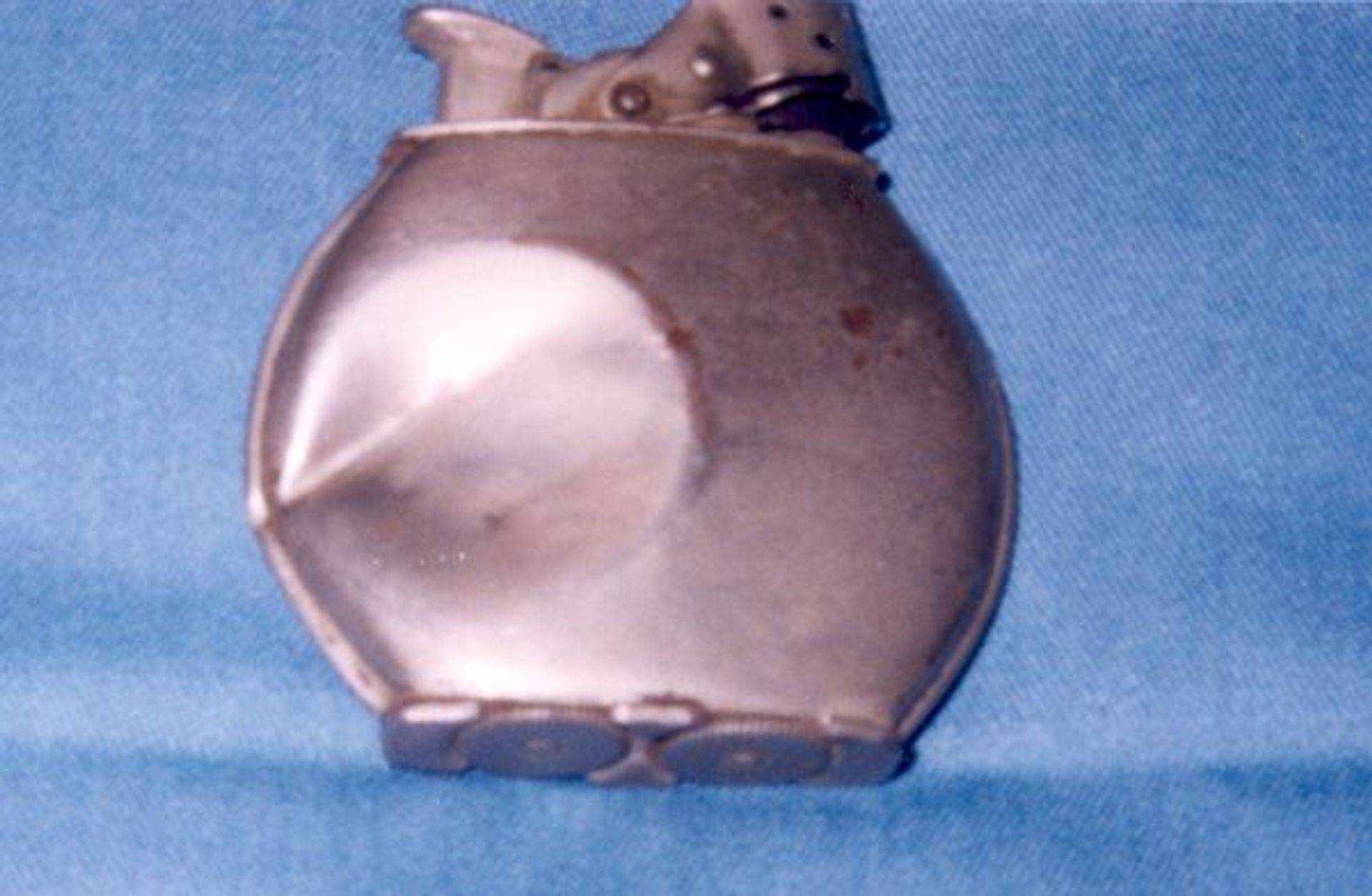
“Truckin’ Mission” September 20, 1944
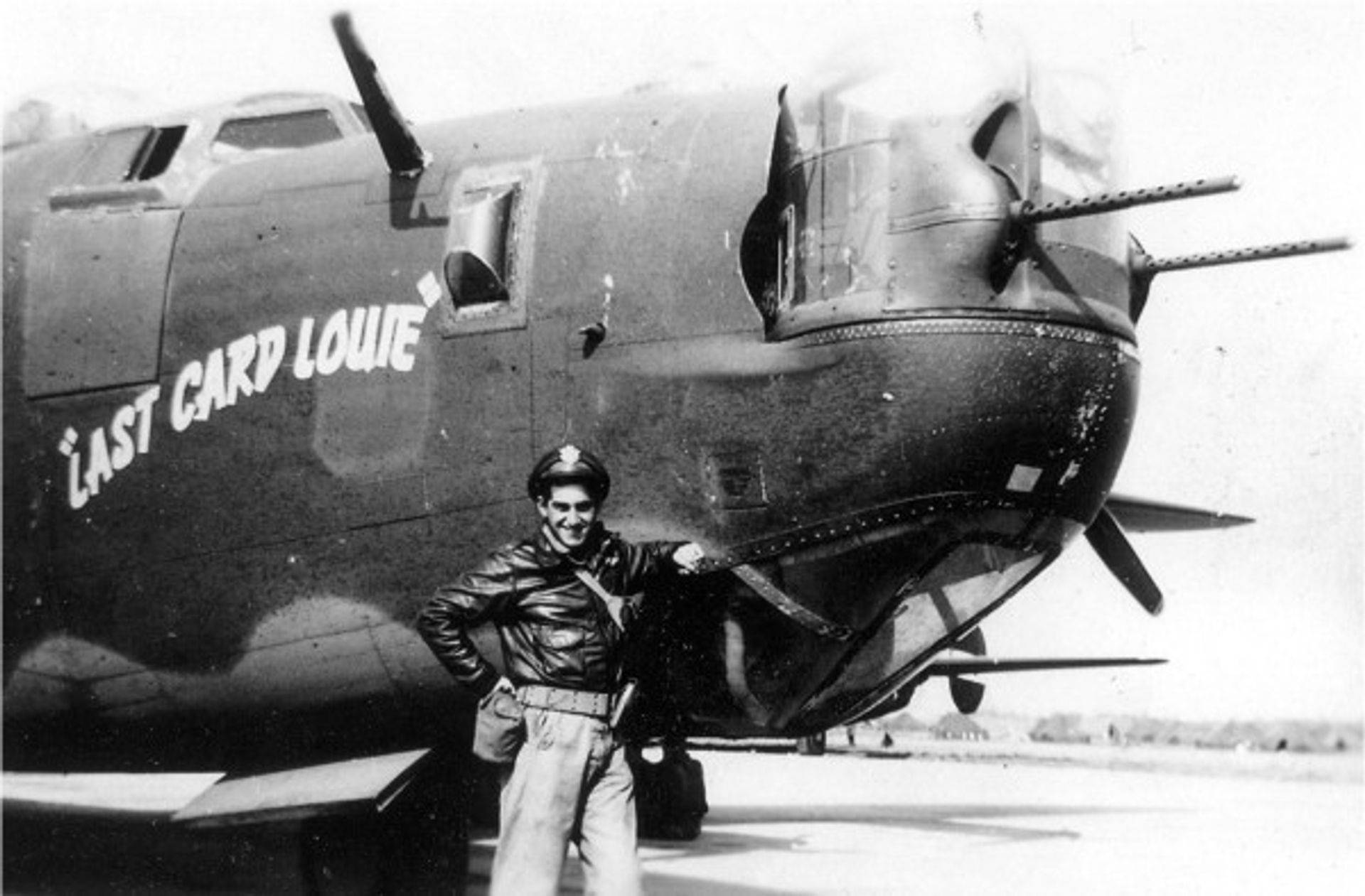
Navigator Ed Silver with ship #441, “Last Card Louie“ at Clastres, France after delivering gas for Patton’s Army
“We flew in at tree top level, dodging bullets fired from ground troops. We flew with four-man crews – pilot, co-pilot, navigator and engineer. I flew as navigator, which was in short supply, so I got to fly a mission almost every day, generally with different pilots.”
(Photo: Ed Silver)
